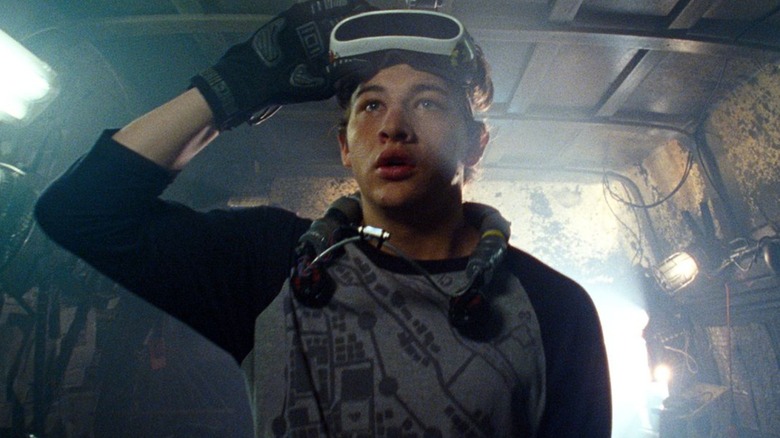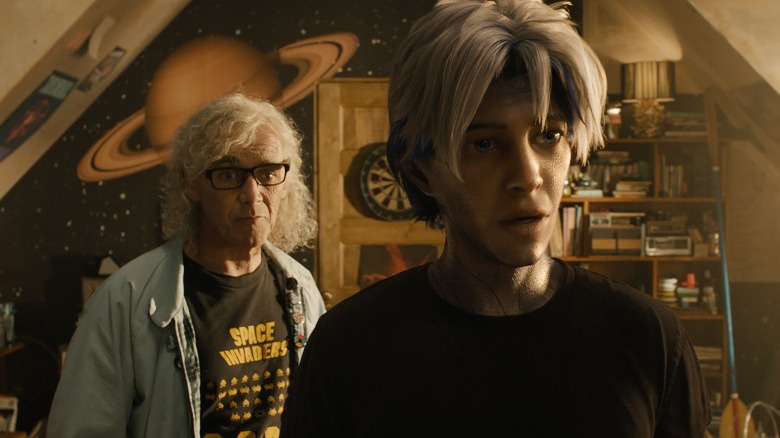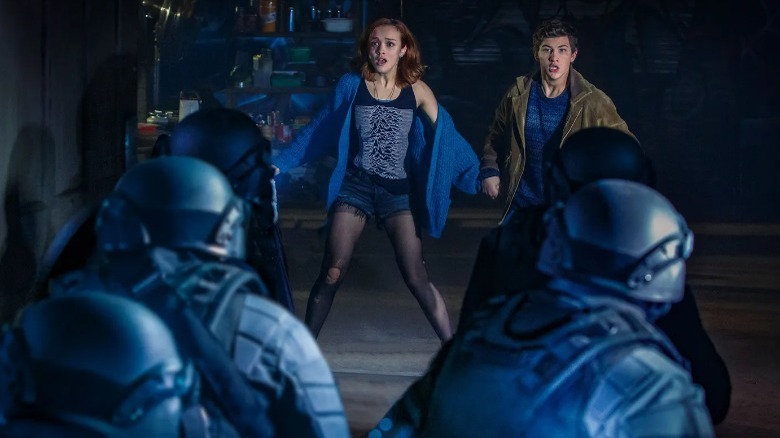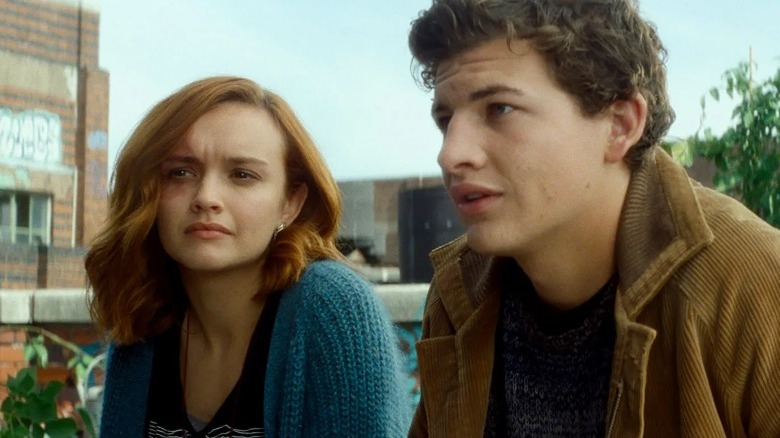Ready Player One Ending Explained: The Power Of Friendship And Why It's Crucial To Touch Grass
When Steven Spielberg decided to adapt Ernest Cline's sci-fi fantasy novel, "Ready Player One," the book underwent critical reappraisal and the reception to the adaptation was mixed. There were good reasons for this to happen: Cline's novel, which was hailed as a heartfelt trip down nostalgia lane when it was first released, was now re-evaluated through the lens of toxic nerd culture that catered predominantly to straight, white males. Moreover, with the advent of Gamergate in early 2014, it became impossible to view Cline's vision as a harmless, escapist fantasy — instead, it read as an exhausting, hollow catalog of '80s pop culture trivia that promotes problematic gatekeeping. More importantly, it props up an escapist fantasy that is exclusionary, misogynistic, and deeply toxic.
Does Spielberg manage to improve upon these aspects in Cline's novel? For the most part, yes. Spielberg is the kind of director who rarely misses: while "Ready Player One" has some quintessential Spielbergian elements, the film's core message is tonally inconsistent, and its ending fails to stick to its landing. Having said that, Spielberg's ending is still remarkably better than that of the books, as it positions Wade/Parzival (Tye Sheridan) as a more sympathetic character who truly believes in the power of friendship and strives to attain middle ground amid a bleak, dystopian setting. The outcome is far from perfect in Spielberg's world, but it still offers a sliver of hope.
Let us dive deeper into the ending of "Ready Player One," what it means for Wade as a protagonist and the far-reaching implications of the same in the film's real world.
You cannot separate art from the artist
The three challenges presented by OASIS creator James Halliday (Mark Rylance), which allow the winner access to the VR world completely, are firmly rooted in Halliday's personal life. Art, after all, is an extension of the self, and Halliday's deepest desires, regrets, and inspirations have been woven into the three Easter Egg challenges, and only someone with an understanding of the creator can become a worthy successor. Wade, being the Halliday-obsessive he is, quickly figures it out during the first challenge: he wins an impossible race by breaking conventional in-game rules which doubles as a metaphor for self-reflection.
The second challenge, which I personally find to be the most interesting one, brings Stephen King/Stanley Kubrick's "The Shining" to life in the most creative manner. The lesson is to "take a leap" of faith and essentially get the girl, which works in tandem with Wade's crush on Art3mis/Samantha (Olivia Cooke). However, Halliday's backstory, which includes his inability to take a step toward the one he loves, reinstates the stereotypical nerd trope wherein folks like Halliday are socially awkward and unable to form meaningful relationships with women. While Samantha enjoys more agency in Spielberg's world, the book props her as a mission to be accomplished, a trophy to be collected.
Halliday's final challenge, which emphasizes the experience of playing an Atari 2600 game without getting hooked on winning, gives way to a final test for Wade. He must refrain from repeating the same mistakes as Halliday and prove himself worthy of a VR system that essentially fuels reality. Wade succeeds but at a great cost.
The power of friendship can topple corporate hegemony
Wade does not accomplish the impossible with the aid of personal perseverance alone. One of his biggest lessons is to share responsibility among the High Five, which he does in the end. Halliday's final message hinges on the bitter truth that while his VR world facilitated endless possibilities and a sense of community, the friendships forged were mostly hollow and means-to-end. There's more to an individual than their digital avatar, as perceived selves are different from real ones. Halliday, who lost himself in pop culture obsession and felt alienated later in life, wanted his successor to connect to his friends in a meaningful way in the real world.
This seems to be a decent-enough lesson, as Wade and his friends work together to topple the corporate tyranny of Nolan Sorrento (Ben Mendelsohn) and IOI. While Wade and his friends are fueled by heroic righteousness in Cline's novel, Spielberg handles the characters with greater nuance. For instance, in the book, Wade infiltrates IOI to lead a revolution from within. In the film, it is Samantha who finds herself a prisoner at IOI — this is not a pre-planned act of bravery, but a tragic, emotionally-charged moment that ties into her backstory.
Samantha's father was an indentured laborer at IOI, and she wants to avenge him and get back at Sorrento. Her friends help her along the way, which makes their actions more grounded in genuine empathy/care as opposed to forming a dream geek team for the sake of it. Samantha is the one who dismantles the force field around Planet Doom, which allows Wade to do what he must. Similarly, it is thanks to Aech's skills that Wade narrowly misses being killed in the real world. Teamwork saved the day in "Ready Player One."
Finding a balance between escapism and reality
Spielberg ends "Ready Player One" with a controversial decision: the OASIS will be completely shut down on Tuesdays and Thursdays, allowing folks to connect with one another in the real world. Go touch grass, Spielberg says, which is not a bad message in of itself, as being perennially online can truly fuel feelings of paranoia, doom, and isolation. However, the way in which this is handled is a bit muddled, despite Spielberg's best attempts to further a balanced vision when it comes to escaping reality and grounding oneself when needed.
In 2045, which is when the events of the film are set, the entire populace is heavily dependent on OASIS to make ends meet. It's a desperate, tragic situation, as players not only use it to feel seen for their nostalgia-based aspirations but also to earn a living amid economically-dire conditions. IOI, the megacorporation, exploits these conditions for limitless profits and tortures indentured laborers for life. While Wade's decision to block IOI's access to OASIS dismantles the corporate megastructure temporarily, how sound is this decision to shut down the VR world two days a week?
When entire livelihoods depend on OASIS, a two-day weekly shutdown seems like a bad idea from an economic standpoint. Moreover, IOI is bound to sprout another hydra head in less-evasive ways, as capitalistic structures always find a way to mooch off people's misery. Although VR disconnection can promote grounded, real-world connections and improved mental health, the film does little to establish the real world as a livable space. The dystopia is as bleak as it gets, and OASIS is a double-edged sword, which acts as an escape and a means to survive. Maybe, just maybe, the new generation can help build a better, livable world in the end.



